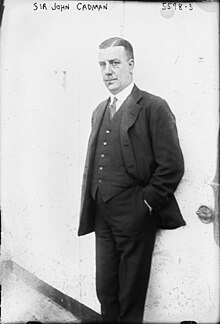John Cadman, 1st Baron Cadman
John Cadman, 1st Baron Cadman (born September 7, 1877 in Silverdale , † May 31, 1941 in Bletchley ) was a British engineer and manager. Among other things, he was chairman of the board of the Anglo-Persian Oil Company for many years .
Life and activity
Cadman was a son of the mining supervisor James Cope Cadman (1851-1914) and his wife Betty, b. Keeling († 1924). He studied at Armstrong College, University of Durham , where he received a degree in geology in 1899. Since 1900 he was a fellow of the Geological Society.
During the first decade of the 20th century, Cadman worked from 1904 as an inspector in mines in Trinidad and Tobago, which at that time still belonged to the British Empire. In this capacity in 1907 he organized the feeding of the oil reserves in Trinidad into the world oil trade.
From 1908 Cadman taught petroleum mining at Birmingham University , and in 1912 he was the first lecturer to offer a course on "Petroleum Engineering".
In the years before the First World War, Cadman advised the British Admiralty (naval management) under the then Secretary of the Navy Winston Churchill as a member of the Admiralty Fuel Commission on converting their ships from coal to oil as fuel. During the war he was a member of the Slade Commission, which traveled to Iran to determine the size and quality of the oil reserves there.
In 1916, Cadman took on duties as a consultant on petroleum issues at the British Colonial Office and as a member of the Advisory Council for Scientific and Industrial Research . When the war conditions in 1917 caused a massive oil shortage in the British Navy, Cadman was appointed director of the British Petroleum Executive .
In 1918 Cadman was promoted to Knight Commander of the Order of St Michael and St George , so that from then on he could call himself "Sir". In 1929 he was awarded the Knight Grand Cross of the same order.
In 1921 Cadman joined the Anglo-Persian Oil Company (APOC) as a technical adviser, where he quickly made a career: On March 26, 1923, Cadman was elected to the position of managing director of the APOC. In 1925, when he was appointed deputy chairman, he became a member of the APOC's senior management. On March 27, 1927, he was finally promoted to CEO of the APOC. He held this position until 1941.
As a supporter of the idea that overly fierce competition between large corporations was detrimental to the business or the profits of the individual competitors, Cadman, as CEO of the APOC, secretly pushed the APOC to work together with the other two large oil companies of the time, the Royal Dutch Shell Corporation and the Standard Oil Company (later Exxon Mobile). This was finally formalized in the so-called As-Is Agreement , a secret agreement between these three corporations, in which they coordinated their economic side-by-side activities in order to protect themselves from the costs of aggressive competition in order to share the profits of the individual in this agreement maximize and at the same time permanently distribute control of the world oil market in the form of an oligopoly divided between three parties in order to secure one's own position by making it difficult, if not impossible, for new companies to emerge on the oil market.
When the Persian Shah canceled the APOC's production concessions in Iran in 1933, Cadman personally negotiated a new agreement with him.
In the 1930s Cadman took on senior official positions in the Anglo-Persian Oil Company, where he received the rank of director.
On June 7, 1937, Cadman was raised to hereditary peer as Baron Cadman , of Silverdale in the County of Stafford, and thereby became a member of the House of Lords . In 1940 he was accepted as a Fellow of the Royal Society . The Cadman Glacier in Graham Land, Antarctica, bears his name in his honor.
Due to his leading position in the British economy, Cadman was targeted by the National Socialist police officers in 1940 at the latest, who classified him as an important target: In the spring of 1940, the Reich Security Main Office in Berlin put him on the special wanted list GB , a directory of people whom the Nazi surveillance apparatus considered considered particularly dangerous or important, which is why, in the event of a successful invasion and occupation of the British Isles by the Wehrmacht, they should be located and arrested by the SS special commands following the occupation troops with special priority.
literature
- HS Torrens: "Cadman, John, first Baron Cadman (1877-1941)", in Oxford Dictionary of National Biography , 2004.
- MS Vassiliou: Historical Dictionary of the Petroleum Industry , 2009, p. 110f.
Web links
- Entry on Cadman in the Encyclopedia Iranica
- Newspaper article about John Cadman, 1st Baron Cadman in the 20th century press kit of the ZBW - Leibniz Information Center for Economics .
Individual evidence
- ↑ a b Knights and Dames: BUL-COL at Leigh Rayment's Peerage
- ^ Peerage: Cadman at Leigh Rayment's Peerage
- ↑ Cadman, Baron (UK, 1937) at Cracroft's Peerage
- ^ Entry on Cadman in the special wanted list GB (reproduced on the website of the Imperial War Museum in London) .
| predecessor | title | successor |
|---|---|---|
| New title created |
Baron Cadman 1937-1941 |
John Cadman |
| personal data | |
|---|---|
| SURNAME | Cadman, John, 1st Baron Cadman |
| BRIEF DESCRIPTION | British engineer and manager |
| DATE OF BIRTH | September 7, 1877 |
| PLACE OF BIRTH | Silverdale |
| DATE OF DEATH | May 31, 1941 |
| Place of death | Bletchley |
